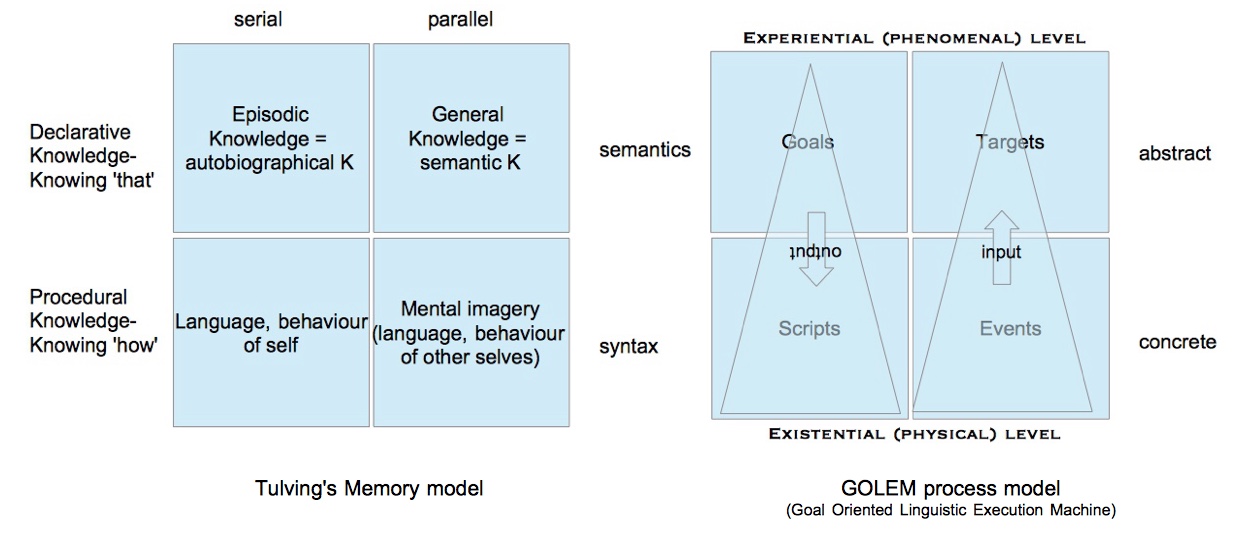Brains of Sand S The Subjective Stance (under construction)

Figure 9.1
It has long been known, but is still not widely appreciated, that the tetrapod brain can be functionally approximated by a pair of duplex (counterflow), hierarchical information processors, one for input, and the other for output. This is as true for humans as it is for fishes. Indeed, we probably share the underlying teleology with most arthropods. The figure at left depicts this basic processor design. Using the ' poverty of stimulus' argument, Noam Chomsky further inferred that linguistic principles underly all higher order brain operations. That is, its internal functioning could be interpreted via syntax and semantics, the familiar mechanisms of message transfer.
The afferent hierarchy is in the business of meaningful representation. In linguistic terms, it extracts the semantics encapsulated within all incoming messages. It takes superthresholded sensory events (significant signals) present in the parietal lobe (or equivalent) and abstracts these signals, constructing conscious percepts (eg of objects). The actual process of conversion involves cybernetics, and Shannon's concept of information as 'the difference that makes a difference'.
The efferent hierarchy is in the business of reproduction. It takes the subjects own narrative (significance, semantics, causes) present in episodic memory (or equivalent) and packages these signals as voluntary goals. It then expands these semantics into a learned syntax, involuntary instructions which function automatically, not unlike computer code scripts.
"There are two hierarchical processes: (an efferent) one that connects the limbic system via the cingulate predominantly with the frontal lobe and another (afferent one) that connects the limbic system via the inferior temporal lobe ...(and) the parietal lobe*".
*from Etienne van der Walt- The limbic system and the "religious brain"

Figure 9.2
The general data structure introduced in figure 9.1 is reproduced at left, with the addition of a few more real-world details.
First consider the right-hand, afferent (bottom-up) hierarchy of the GOLEM (Goal-Oriented Linguistic Emulation of Mind). Whenever sensory inputs increase to super-threshold levels, they become sensory events. All understanding of the surrounding world follows from pressure events on skin, or pressure-like events on modified internal skin patches such as the retinas and the eardrums. Remember also that otoliths in the inner ear respond to inertial inputs (accelerations). Certain patterns of multiple events are interpreted (abstracted) as numerically smaller matching patterns (or percepts). That is, there has been a hierarchical compression of information. For example, the sequences of pressure events on the soles of the feet are interpreted as self-motion (eg walking). This is an information process called automation, or triggering.
Now consider the left-hand, efferent (top-down) hierarchy of the GOLEM (canonical computer). Sensory observations in the right hierarchy are correlated with motor activity in the GOLEM's left hand hierarchy. Indeed, pursuit of voluntary efferent patterns (goals) is one of the main drivers of GOLEM computational processing. These left-GOLEM goals consist of conscious motion (animation) of right-GOLEM patterns, a behaviour called cognitive targeting.
Note the deliberate comparison being drawn between the functions of the major cerebral lobes (frontal, temporal, limbic and parietal) and the quadrants of the GOLEM.
What is consciousness? That's a silly question, actually. Everyone knows what it is, it is that part of the mind of 'everyone' that pays attention, that knows stuff. It is the thing that the self does when it is not sleeping. When I ask that question, really I am asking 'how is it done, what mechanism does the brain use to produce this state of awareness and attention and knowledgeable association?'. We can build up a mechanistic notion of consciousness using the GOLEM, the simplest of all my models.
Figure 9.3
(a) (b)

